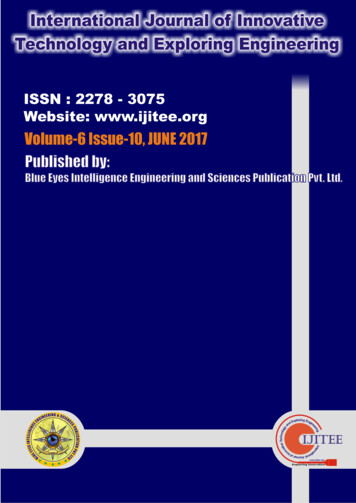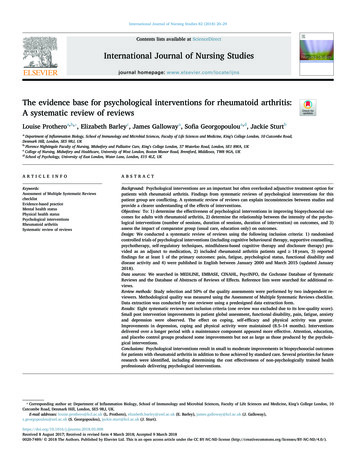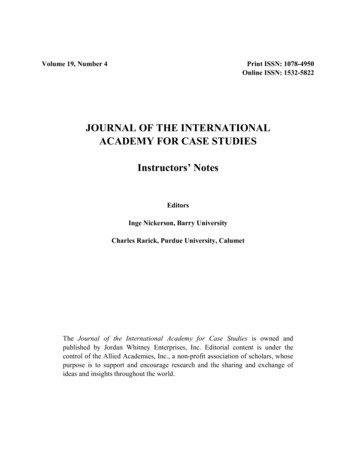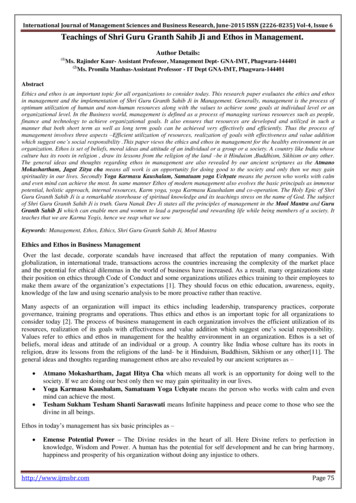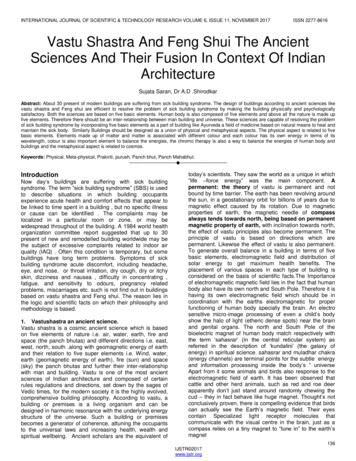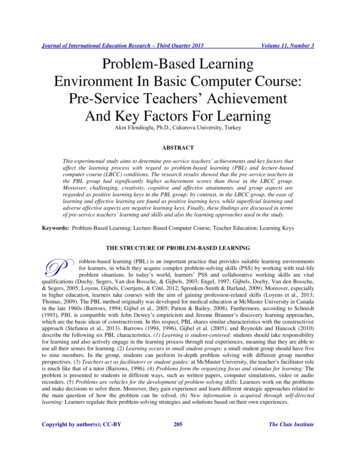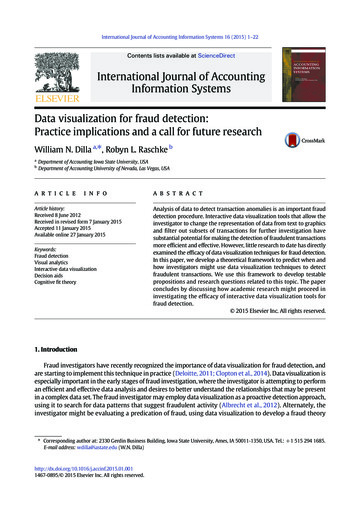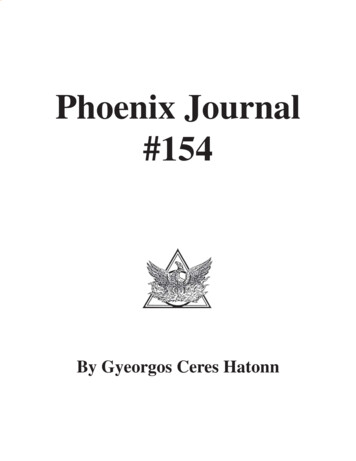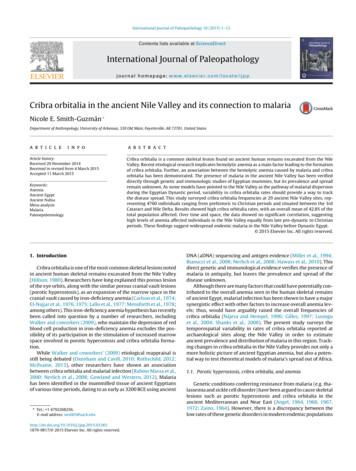
Transcription
International Journal of Paleopathology 10 (2015) 1–12Contents lists available at ScienceDirectInternational Journal of Paleopathologyjournal homepage: www.elsevier.com/locate/ijppCribra orbitalia in the ancient Nile Valley and its connection to malariaNicole E. Smith-Guzmán Department of Anthropology, University of Arkansas, 330 Old Main, Fayetteville, AR 72701, United Statesa r t i c l ei n f oArticle history:Received 29 November 2014Received in revised form 4 March 2015Accepted 11 March 2015Keywords:AnemiaAncient EgyptAncient NubiaMeta-analysisMalariaPaleoepidemiologya b s t r a c tCribra orbitalia is a common skeletal lesion found on ancient human remains excavated from the NileValley. Recent etiological research implicates hemolytic anemia as a main factor leading to the formationof cribra orbitalia. Further, an association between the hemolytic anemia caused by malaria and cribraorbitalia has been demonstrated. The presence of malaria in the ancient Nile Valley has been verifieddirectly through genetic and immunologic studies of Egyptian mummies, but its prevalence and spreadremain unknown. As some models have pointed to the Nile Valley as the pathway of malarial dispersionduring the Egyptian Dynastic period, variability in cribra orbitalia rates should provide a way to trackthe disease spread. This study surveyed cribra orbitalia frequencies at 29 ancient Nile Valley sites, representing 4760 individuals ranging from prehistoric to Christian periods and situated between the 3rdCataract and Nile Delta. Results showed high cribra orbitalia rates, with an overall mean of 42.8% of thetotal population affected. Over time and space, the data showed no significant correlation, suggestinghigh levels of anemia affected individuals in the Nile Valley equally from late pre-dynastic to Christianperiods. These findings suggest widespread endemic malaria in the Nile Valley before Dynastic Egypt. 2015 Elsevier Inc. All rights reserved.1. IntroductionCribra orbitalia is one of the most common skeletal lesions notedin ancient human skeletal remains excavated from the Nile Valley(Hillson, 1980). Researchers have long explained this porous lesionof the eye orbits, along with the similar porous cranial vault lesions(porotic hyperostosis), as an expansion of the marrow space in thecranial vault caused by iron-deficiency anemia (Carlson et al., 1974;El-Najjar et al., 1976, 1975; Lallo et al., 1977; Mensforth et al., 1978;among others). This iron-deficiency anemia hypothesis has recentlybeen called into question by a number of researchers, includingWalker and coworkers (2009), who maintain the depression of redblood cell production in iron-deficiency anemia excludes the possibility of its participation in the stimulation of increased marrowspace involved in porotic hyperostosis and cribra orbitalia formation.While Walker and coworkers’ (2009) etiological reappraisal isstill being debated (Oxenham and Cavill, 2010; Rothschild, 2012;McIlvaine, 2013), other researchers have shown an associationbetween cribra orbitalia and malarial infection (Rabino Massa et al.,2000; Nerlich et al., 2008; Gowland and Western, 2012). Malariahas been identified in the mummified tissue of ancient Egyptiansof various time periods, dating to as early as 3200 BCE using ancient Tel.: 1 4792268256.E-mail address: 15.03.0011879-9817/ 2015 Elsevier Inc. All rights reserved.DNA (aDNA) sequencing and antigen evidence (Miller et al., 1994;Bianucci et al., 2008; Nerlich et al., 2008; Hawass et al., 2010). Thisdirect genetic and immunological evidence verifies the presence ofmalaria in antiquity, but leaves the prevalence and spread of thedisease unknown.Although there are many factors that could have potentially contributed to the overall anemia seen in the human skeletal remainsof ancient Egypt, malarial infection has been shown to have a majorsynergistic effect with other factors to increase overall anemia levels; thus, would have arguably raised the overall frequencies ofcribra orbitalia (Nájera and Hempel, 1996; Gilles, 1997; Lusinguet al., 2004; Shanks et al., 2008). The present study surveys thetemporospatial variability in rates of cribra orbitalia reported atarchaeological sites along the Nile Valley in order to estimateancient prevalence and distribution of malaria in this region. Tracking changes in cribra orbitalia in the Nile Valley provides not only amore holistic picture of ancient Egyptian anemia, but also a potential way to test theoretical models of malaria’s spread out of Africa.1.1. Porotic hyperostosis, cribra orbitalia, and anemiaGenetic conditions conferring resistance from malaria (e.g. thalassemia and sickle cell disorder) have been argued to cause skeletallesions such as porotic hyperostosis and cribra orbitalia in theancient Mediterranean and Near East (Angel, 1964, 1966, 1967,1972; Zaino, 1964). However, there is a discrepancy between thelow rates of these genetic disorders in modern endemic populations
2N.E. Smith-Guzmán / International Journal of Paleopathology 10 (2015) 1–12and the high rates of these skeletal lesions within ancient populations (Hengen, 1971). Consequently, paleopathologists turnedto iron-deficiency anemia, a main contributor to anemia in modern populations, as the main causative agent implicated for theselesions (Hengen, 1971; Carlson et al., 1974; El-Najjar et al., 1976;Lallo et al., 1977; Mensforth et al., 1978; Stuart-Macadam, 1987).This hypothesis has been linked with agriculture through studiesshowing higher rates of porotic hyperostosis and cribra orbitalia inmaize agriculturalists as compared with populations whose dietsincluded meat (El-Najjar et al., 1976).The porous lesions of the vault (porotic hyperostosis) and thoseof the orbits (cribra orbitalia) tend to show a connection, but alsovariability, in etiology (Stuart-Macadam, 1989; Walker et al., 2009).Some consider cribra orbitalia as an early indicator of anemia, andporotic hyperostosis as an indicator of a more chronic, long termanemic state (Hrdlička, 1914; Caffey, 1937). Only children tend todisplay active lesions, leading to the widely held explanation thatthese lesions form during childhood and are only maintained dueto lack of bone turnover in adults (Stuart-Macadam, 1985; Mittlerand Van Gerven, 1994).However, many anthropologists have pointed out flaws in theiron-deficiency anemia hypothesis. Many discredit the attributionof dietary lack of iron as the main causative factor of the cranial lesions, and have instead suggested a multi-factorial etiologyincluding diet and other factors such as parasitic and diarrhealdisease (Hengen, 1971; Lallo et al., 1977; Mensforth et al., 1978;Walker, 1986; Holland and O’Brien, 1997; Wapler et al., 2004).However, the role of parasites in the etiology of cribra orbitalia hasalso been disputed (DeGusta, 2009). Gleń-Haduch and coworkers(1997) found no significant correlations between the levels of ironin teeth and presence of cribra orbitalia, suggesting other etiologicalfactors are more important than lack of iron in the development ofthis lesion. Further, McClure and coworkers (2011) found high ratesof cribra orbitalia with concurrent high isotopic levels of dietaryanimal protein in a population in Spain, precluding the possibilityof iron-deficiency.The biggest criticism of the iron-deficiency anemia hypothesiscame in an article by Walker and coworkers (2009). They reasonedthat iron-deficiency anemia could not in fact induce the bone marrow hypertrophy responsible for producing these lesions becausethis type of anemia depresses red blood cell production. Instead,they pointed to megaloblastic and hemolytic anemia as the mainfactors triggering the formation of these skeletal lesions. The formertype of anemia arises in individuals with a nutritional deficiency inB12 , and the latter arises in individuals with genetic disorders conferring protection from malaria, as well as in individuals with amalarial infection (Walker et al., 2009).Walker’s article is still a matter of debate currently, with someresearchers suggesting that iron deficiency could still contributeto marrow space expansion because it causes ineffective erythropoiesis rather than a complete dyserythropoiesis (Oxenham andCavill, 2010). However, others refute this ineffective erythropoiesisclaim, and instead insist that iron deficiency anemia is a sideeffect, not the cause, of porotic hyperostosis (Rothschild, 2012). Further, McIlvaine (2013) suggests that if the iron-deficiency anemiahypothesis is refuted, the B12 deficiency explanation should also berefuted because the mechanisms behind both types of anemia arethe same. At this point, the exact etiology of porotic hyperostosisand cribra orbitalia remains uncertain, but appears to a combination of many factors (McIlvaine, 2013).1.2. Differential diagnosis of anemia in the Nile ValleyThe high frequencies of cribra orbitalia in the Nile Valleyhave been attributed to many causes, including schistosomiasis,intestinal worms, dietary deficiencies, brucellosis, and malaria.Schistosomiasis (a blood fluke infection) in ancient Egypt has beenevidenced directly from mummified tissues and indirectly fromancient texts (Brier, 2004). However, antigenic evidence of schistosoma infection was not shown to associate with skeletal lesionsof anemia in non-adults at the Nubian site of Semna South (Alvrus,2006: 167), indicating other etiological factors are more importantthan schistosomiasis in the formation of these lesions in the NileValley.Hookworms, common in modern tropical areas, are a notorious cause of iron-deficiency anemia, and have been implicatedin causing higher rates of cribra orbitalia in equatorial areas(Hengen, 1971). If Walker and coworkers’ (2009) position that irondeficiency anemia is unable to cause porotic hyperostosis and cribraorbitalia is correct, then this type of anemia would be unlikely togenerate these lesions. Vitamin B12 deficiency caused by hookworminfestation could be a factor, as the malabsorption of nutrients dueto chronic diarrhea is attributed to megaloblastic anemia, which hasbeen implicated as a cause of marrow hypertrophy (Walker et al.,2009; but see McIlvaine, 2013 for critique). Nevertheless, VitaminB12 deficiency-induced megaloblastic anemia is not a major contributor to total anemia worldwide, even in tropical, developingnations (Kassebaum et al., 2014). Therefore, neither hookwormsnor other sources of Vitamin B12 deficiency were likely responsiblefor high skeletal anemia rates in the Nile Valley.Brucellosis is a disease underestimated by paleopathologists inthe past, consisting of a bacterial zoonotic infection passed fromdomestic cattle to humans usually through ingestion of raw milk(D’Anastasio et al., 2011). Brucellosis causes undulating fevers andhemolytic anemia similar to malaria, potentially inducing skeletallesions of anemia like cribra orbitalia. However, brucellosis maintains a low prevalence in humans, even in high-risk occupationalgroups like dairy farmers (Lopes et al., 2010). Due to this low prevalence, and even lower chance of anemia severe enough to makea mark on the skeleton, it is not likely that high rates of skeletalanemia in the Nile Valley were caused by this disease.Malaria is a disease caused by parasites of the genus Plasmodium,which is transmitted by the Anopheles mosquito vector. There arefive species of the parasite known to infect humans: Plasmodium falciparum, Plasmodium vivax, Plasmodium malariae, Plasmodium ovale,and Plasmodium knowlesi. Malaria is one of the causative agentsimplicated for the chronic anemia pattern in the ancient Nile Valley. In ancient Egyptian medical texts, the annual plague describedin the Edwin Smith Surgical Papyrus has been attributed to seasonalepidemics of malaria during periods of annual Nile River flooding(Brier, 2004). This disease does not discriminate against age or class,although it does contribute to higher rates of anemia in womenand children (World Health Organization, 2014). Malaria is knownto cause hemolytic anemia, which is capable of producing marrowhyperplasia (Walker et al., 2009). In addition to the classic modelof skeletal anemia by expansion of marrow space, recent clinicalresearch has suggested that the hemolysis occurring during theschizogony phase of a malarial infection may contribute to porousskeletal lesion formation due to the release of acid phosphate, freeheme, and the malarial pigment hemozoin into the bloodstream.This leads to an imbalance in bone remodeling by stimulatingosteoclasts while simultaneously impairing osteoblasts (D’Souzaet al., 2011; Moreau et al., 2012). Furthermore, severe malarial anemia may induce extramedullary erythropoiesis, which is known tocause cortical thinning and coarse trabeculation (Al-Aabassi andMurad, 2005). Malaria is also known to have a synergistic effectwith other diseases, combining especially with respiratory anddiarrheal diseases as the most important factor in all-cause mortality in historical and modern accounts of epidemics (Duffy, 1952;Boyd, 1999; Shanks et al., 2008). This synergistic tendency suggestsmalaria may have a strong impact on all-cause anemia in areasendemic for the disease by increasing the total anemia burden.
N.E. Smith-Guzmán / International Journal of Paleopathology 10 (2015) 1–12Caution must be taken when considering the rates of cribraorbitalia reported in the Nile Valley due to the possibility formisdiagnosis (Wapler et al., 2004). Eye infections seem to havebeen common in ancient Egypt, with descriptions and treatmentsfor such ailments appearing in medical papyri (Andersen, 1997;Heagren, 2003; Scheidel, 2012). It is likely that some of the cribraorbitalia reported at sites in the Nile Valley was caused by suchsuperficial lesions or inflammation rather than a systemic causesuch as anemia. However, eye infections such a trachoma and glaucoma are common in other areas of the world as well; thus, are notlikely to have had
4760 individuals ranging from prehistoric to Christian periods and situated between the 3rd Cataract and Nile Delta. Results showed high cribra orbitalia rates, with an overall mean of 42.8% of the total population affected. Over time and space, the data showed no significant correlation, suggesting high levels of anemia affected individuals in the Nile Valley equally from late pre-dynastic .
